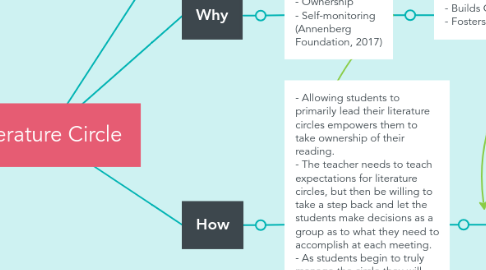
1. What
1.1. Independent Choice
1.1.1. Student Collaboration
1.1.1.1. Online Dicussion
1.1.1.1.1. Reflection
2. Why
2.1. - Empowerment - Ownership - Self-monitoring (Annenberg Foundation, 2017)
2.1.1. - Builds Communication - Fosters teamwork (Fink)
2.1.1.1. - "Authentic literary community" (Blau, 2010) and real world similarities
2.1.1.1.1. - Reflection on both group participation and the reading itself will build a reader who understands the value of sharing their thoughts with others after reading (Fink)
3. How
3.1. - Allowing students to primarily lead their literature circles empowers them to take ownership of their reading. - The teacher needs to teach expectations for literature circles, but then be willing to take a step back and let the students make decisions as a group as to what they need to accomplish at each meeting. - As students begin to truly manage the circle they will make those independent decisions. - The teacher needs to monitor the groups regularly to guide them if the decisions made are not productive.
3.1.1. - Defined roles in literature circles will encourage student to collaborate in different ways each time they meet. The roles I use will be the same as those defined by Fink in her lesson plan on ReadWriteThink.org
3.1.1.1. Students will be required to respond to one another online with original posts. These posts could come from their roles as outlined by Fink or from new thoughts they have independent from the group. Commenting on each others' posts will help create an online community like the one they may experience as an adult reader.
3.1.1.1.1. Students can reflect on both their group participation and their option of the book. The group participation reflection could look like the resource provided on ReadWriteThink.org http://www.readwritethink.org/files/resources/lesson_images/lesson19/groupwork.pdf
3.1.1.1.2. They can also create projects in various forms such as the students do in the classroom from the Annenberg Foundation video.
